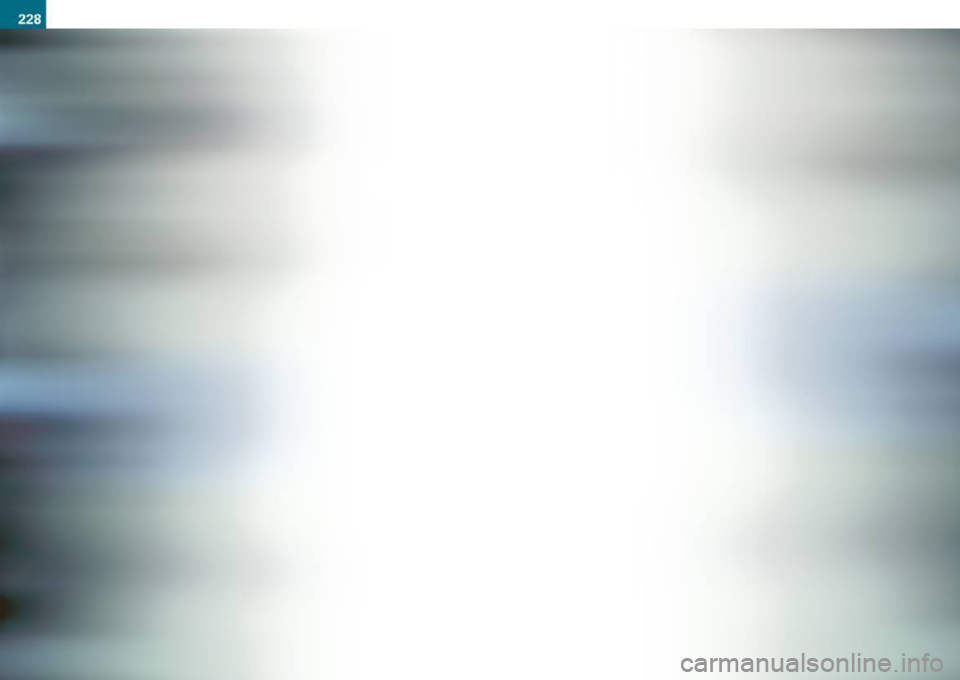AUDI S4 CABRIOLET 2009 Owners Manual
Manufacturer: AUDI, Model Year: 2009, Model line: S4 CABRIOLET, Model: AUDI S4 CABRIOLET 2009Pages: 340, PDF Size: 77.32 MB
Page 221 of 340
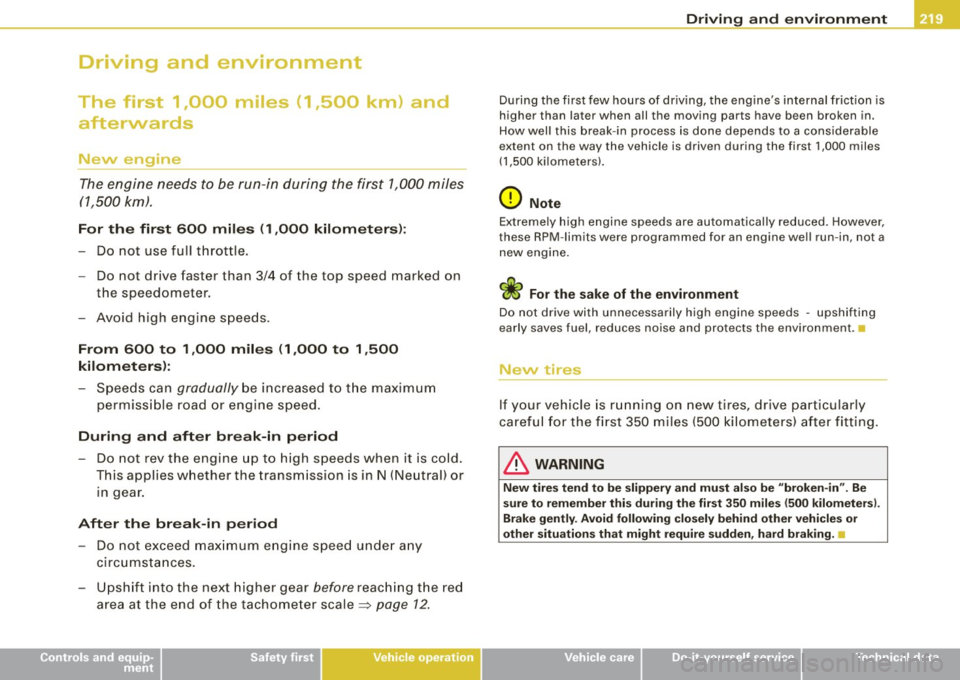
Driving and environment
The first 1 ,000 miles (1,500 km) and afterwards
New engine
The engine needs to be run-in during the first 1,000 miles
(1,500 km).
For th e fir st 600 mil es (1 ,000 kil omet ers):
Do not use full throttle.
- Do not drive faster than 3/4 of the top speed marked on
the speedometer.
- Avoid high engine speeds .
Fr om 600 to 1 ,000 mil es (1,000 to 1 ,500
kilom ete rs ):
- Speeds can gradually be increased to t he maximum
permiss ible road or engine speed .
During and aft er br eak-in p eri od
- Do not rev the engine up to high speeds when it is cold. This applies whether the transm ission is in N (Neutral) or
1n gear.
After the br eak -in period
- Do not exceed max imum e ngine speed unde r any
circumstances.
- Upshift into the next higher gear before reaching t he red
area at the end of the tachome ter scale ~ page 12 .
Controls and equip
ment Safety first Vehicle operation
Driving
and environm ent
During the first few hours of driving, the eng ine's internal friction is
higher than later when all the moving parts have been broken in.
How well this break-in process is done depends to a cons iderable
extent on the way the vehicle is driven during the first 1,000 miles
(1,500 ki lometers).
0 Not e
Extremely high engine speeds are automatically reduced. However,
these RPM -limits were programmed for an engine we ll run-in , not a
new engine .
~ For the sake of the environment
Do not drive with unnecessarily high engine speeds -upshifting
early saves fuel , reduces noise and protects the environment.
New tires
If your v ehicle is r un ning on new tires, driv e particularly
carefu l for the first 350 miles (500 ki lometers) after fitting.
& WARNING
New tire s te nd to b e slipp ery and mu st al so be " brok en -in ". Be
su re t o reme mber thi s during th e fir st 350 m ile s (5 00 kil ome ters).
Br ake gent ly. A vo id following clo se ly behind oth er vehicle s or
ot her situ ati ons that might requi re su dd en , har d b raking.•
Vehicle care Do-it-yourself service Technical data
Page 222 of 340
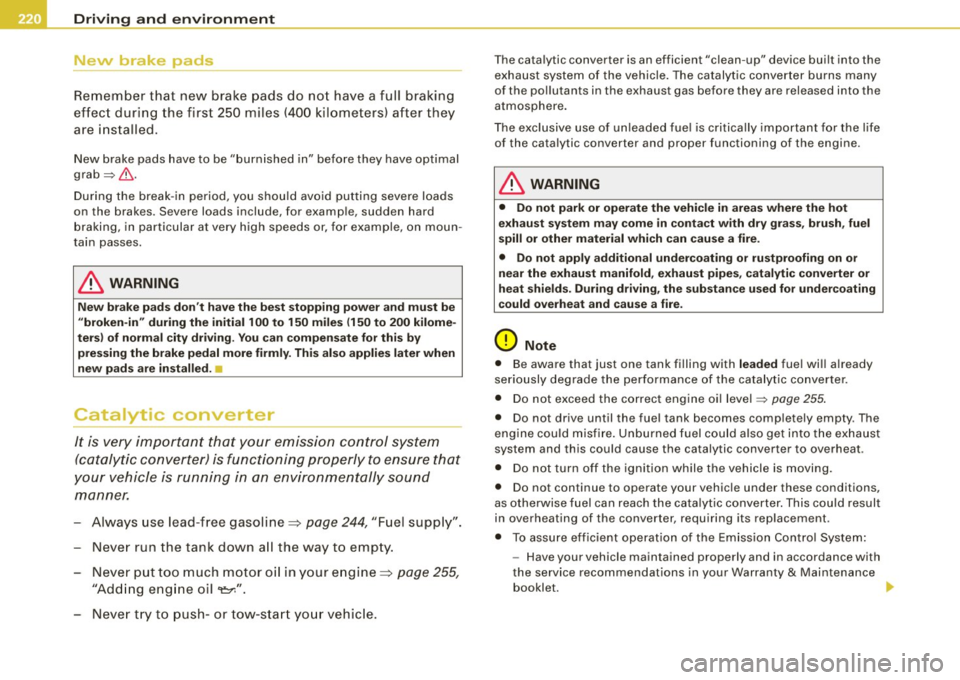
___ D_ r_i v_ in_,.. g"'- a_ n_ d_ e_ n_ v_i_r _o _n_ m_ e_n_ t _______________________________________________ _
New brake pads
Remember that new brake pads do not have a full braking
effec t during the first 250 miles (400 kilometers) after they
are installed .
New brake pads have to be "burn ished in" before they have optimal
grab =>& .
During the break -in period, you shou ld avoid putting severe loads
on the brakes . Severe loads include, for examp le, sudden hard
braking, in particular at very high speeds or, for example, on moun
tain passes.
& WARNING
Ne w brake p ad s don't h ave the bes t sto pp in g po we r and mu st b e
"brok en-in " durin g the initial 100 to 1 50 m il es ( 150 to 200 kil ome
t e rs) of norm al cit y dri ving . Y o u can com pensat e for thi s by
p re ss ing the br ake p ed al more firm ly. Th is also appli es later w he n
n ew pad s a re in sta lled.
:J
Catalytic converter
It is very important that your emission control system
(catalytic converter) is functioning properly to ensure that
y o ur vehicle is running in an environmentally sound
manner.
- Always use lead-free gasoline=> page 244, "Fuel supply".
- Never run the tank down a ll the way to empty.
- Never put too much motor o il in your engine =>
page 255,
"Adding eng ine oi l 'l:::r.11
•
- Neve r try to push -or tow -s ta rt yo ur vehic le.
The catalytic converter is an efficient "clean-up" device built into the
exhaust system of the vehicle. The catalytic converter burns many
of the po llutants in the exhaust gas before they are released into the
atmosphere.
The exc lusive use of unleaded fue l is critica lly important for the l ife
of the cata lytic converter and proper functioning of the engine.
& WARNING
• Do not p ark or op erate th e veh icle in are as w here the h ot
ex hau st sys tem m ay come in co ntac t w ith dr y gr ass, brush , fuel
s pill or other mater ial which can cau se a fire .
• Do not apply a dditi ona l u nder coating or ru stpr oofing on or
n ea r the exhau st m anifold , exhau st pipe s, ca ta lytic conv ert er or
h eat shie ld s. Dur in g d riving , the sub sta nce use d fo r und ercoa ting
coul d ove rhea t and cause a fire .
0 Note
• Be aware that just one tank filling with leaded fue l wi ll already
seriously degrade the performance of the catalytic converter.
• Do not exceed the correct engine oi l level =>
page 255.
• Do not drive until the fuel tank becomes comp letely empty . The
engine cou ld misfire. Unburned fuel could also get into the exhaust
system and this could cause the catalytic conver ter to overheat .
• Do not turn off the ignition while the vehicle is moving.
• Do not con tinue to operate your vehicle under these conditions,
as otherwise fuel can reach the cata lytic converter . This cou ld result
in overheating of the converter, requiring its rep lacement .
• To assure eff icient operation of the Em ission Control System:
- Have your vehicle maintained properly and in accordance with
the service recommendations in your Warranty
& Maintenance
booklet. •
Page 223 of 340
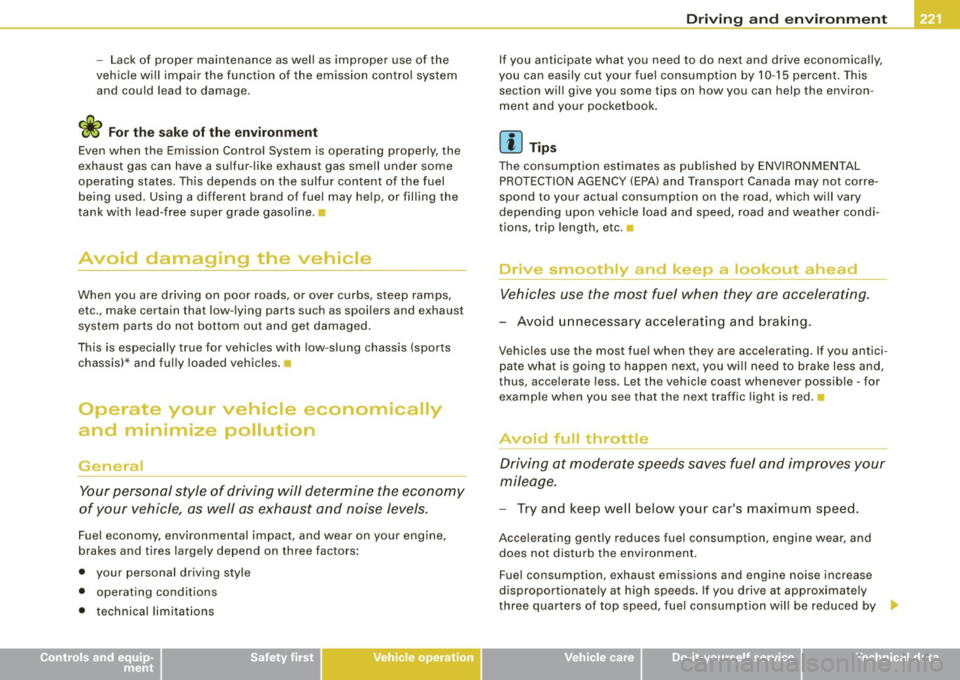
- Lack of proper maintenance as wel l as improper use of the
vehic le wi ll impair the function of the emission control system
and could lead to damage.
'£> For the sake of the environm ent
Even when the Emission Control System is operating properly, the
exhaust gas can have a su lfur -like exhaust gas sme ll under some
operating states. This depends on the sulfur content of the fuel
being used. Using a different brand of fue l may help, or filling the
tank with lead-free super grade gasoline. •
Avoid damaging the vehicle
When you are driving on poor roads, or over curbs, steep ramps,
etc., make certain that low- lying parts such as spoilers and exhaust
system parts do not bottom out and get damaged.
This is especially true for vehicles with low -slung chassis (sports
chassis)* and fully loaded vehicles.
a
Operate your vehicle economically
and minimize pollution
General
Your personal style of driving will determine the economy
of your vehicle, as well as exhaust and noise levels.
Fuel economy, environmental impact, and wear on your engine,
brakes and tires largely depend on three factors:
• your personal driving style
• operating cond itions
• technica l limitat ions
Controls and equip
ment Safety first Vehicle operation
Driving
and environm ent
If you anticipate what you need to do next and drive economica lly,
you can easily cut your fuel consumpt ion by 10 -15 percent . This
section wil l give you some tips on how you can help the environ
ment and your pocketbook.
[ i ] Tips
The consumption est imates as published by ENV IRONMENTAL
PROTECTION AGENCY (EPA) and Transport Canada may not corre
spond to your actua l consumption on the road, which will vary
depending upon vehicle load and speed, road and weather condi
tions, trip length, etc. •
Drive smoothly and keep a lookout ahead
Vehicles use the most fuel when they ore accelerating .
-Avoid unnecessary accelerating and brak ing.
Vehicles use the most fue l when they are accelerating . If you antici
pate what is going to happen next, you wi ll need to brake less and,
thus, acce lerate less. Let the vehicle coast whenever possib le - for
examp le when you see that the next traffic light is red. •
Avoid full throttle
Driving at moderate speeds saves fuel and improves your
mileage.
-Try and keep well below your car's maximum speed.
Acce lerating gently reduces fuel consumption, engine wear, and
does not disturb the environment.
Fue l consumption, exhaust emissions and engine noise increase
disproportionately at high speeds . If you drive at approximately
three quarters of top speed, fuel consumption wil l be reduced by •
Vehicle care Do-it-yourself service Technical data
Page 224 of 340
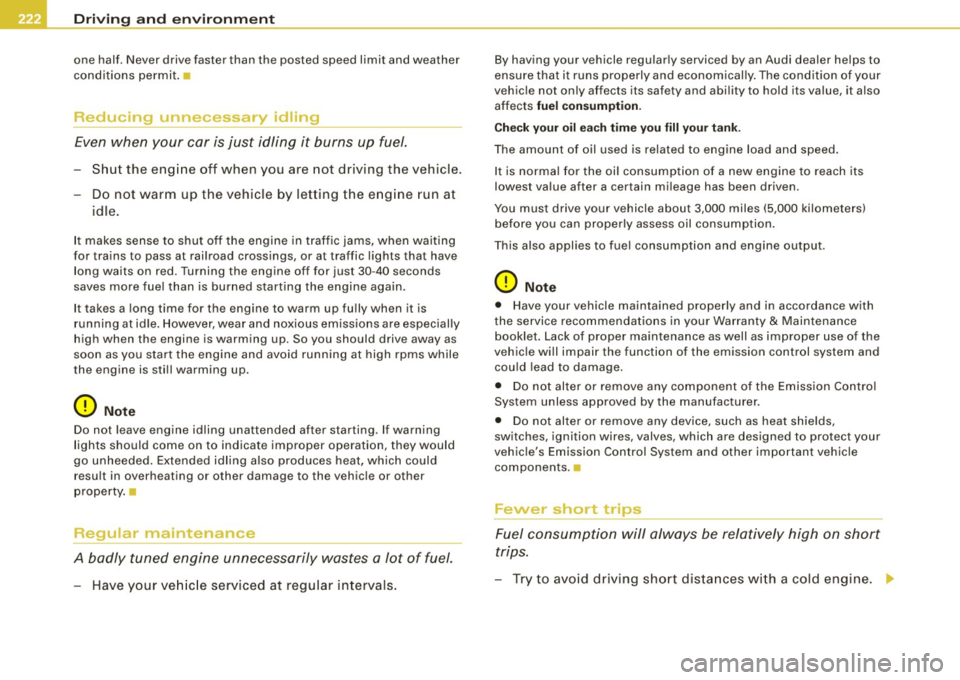
-Dri
ving and environm ent --=---------------
one half . Never drive faster than the posted speed limit and weather
conditions permit .•
Reducing unnecessary idling
Even when your car is just idling it burns up fuel.
- Shut the eng ine off when you are not driving the vehicle.
- Do not warm up the vehicle by letting the engine run at
idle.
It makes sense to shut off the engine in traffic jams, when waiting
for trains to pass at rai lroad crossings, or at traffic lights that have
long waits on red. Turning the engine off for just 30 -40 seconds
saves more fuel than is burned s tarting the engine again .
It takes a long time for the engine to warm up fully when it is
running at idle. However, wear and noxious emissions are especially
high when the engine is warming up. So you should drive away as
soon as you star t the engine and avoid running at high rpms while
the engine is still warming up.
0 Note
Do not leave engine idling unattended after starting . If warning
lights should come on to indicate improper operation, they would
go unheeded. Extended id ling also produces heat, which could
resu lt in overheating or other damage to the veh icle or other
property .•
Regu1ar maintenance
A badly tuned engine unnecessarily wastes a lo t of fuel.
- Have your ve hicle serviced at regular intervals . By having your vehicle regularly serviced by an Audi dealer helps to
ensure that it runs properly and economical
ly . The condit ion of yo ur
vehic le not only affects its safety and abi lity to hold its va lue, it also
affects
fuel consumpt ion .
C heck your oil each time you fill your tank .
The amount of oil used is related to engine load and speed.
I t is norma l for the oil consumption of a new engine to reach its
lowest va lue after a certain mi leage has been driven.
You must drive your vehicle about 3,000 miles (5,000 kilometers) be fore you can properly assess oil consumption .
This also applies to fuel consumption and engine output .
0 Note
• Have your vehicle maintained properly and in accordance with
the service recommendations in your Warranty
& Maintenance
booklet. Lack of proper maintenance as well as improper use of the
vehic le wi ll impai r the function of the em ission control system and
cou ld lead to damage.
• Do no t alter or re move any component of the Emiss ion Contro l
System unless approved by the manufacturer.
• Do not alte r or remove any device, such as heat shields,
switches, ignition wires, valves, which are designed to protect your
vehic le's Emission Control System and other important veh icle
components. •
Fewer short trips
Fu el consumption will alw ays be rela tively high o n short
trips.
- Try to avo id d riving short dista nces wi th a cold engine. _,
Page 225 of 340
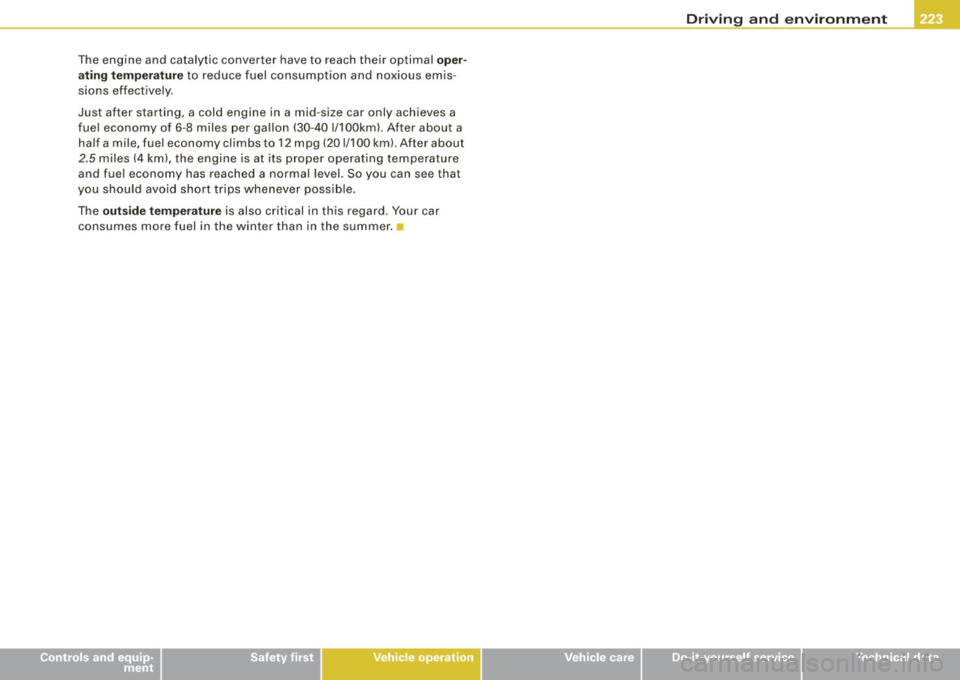
The engine and catalytic converter have to reach their optimal oper
ating temper ature
to reduce fuel consumption and noxious emis
sions effective ly.
Just after starting, a cold engine in a mid -size car only achieves a
fue l economy of 6-8 miles per gallon (30-40 1/100k m). After about a
half a mile, fuel economy climbs to 12 mpg (201/100 kml. After about
2.5 miles (4 km), the engine is at its proper operating temperature
and fuel economy has reached a normal level. So you can see that
you should avo id short tr ips whenever possib le .
The
outs ide temperat ure is also critical in this regard. Your car
consumes more fuel in the winter than in the summer. •
Controls and equip
ment Safety first Vehicle operation
Driving
and environm ent
Vehicle care Do-it-yourself service Technical data
Page 226 of 340
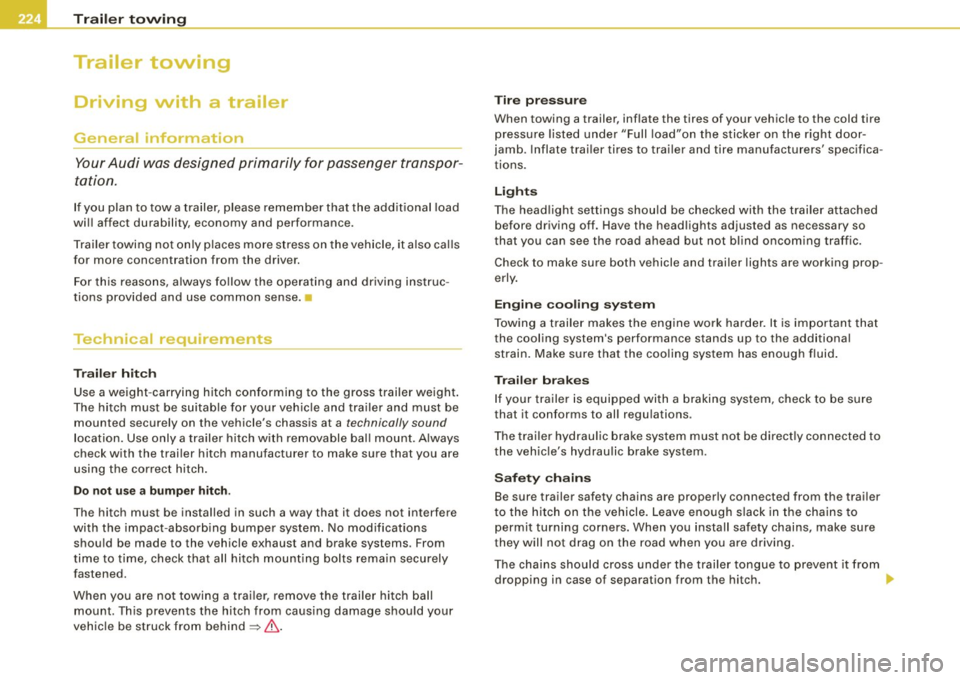
___ T_ r _a_ il_e _r_ t_ o_ vv_ in__... g,_ __________________________________________________ _
Trailer towing
Driving with a trailer
General information
Your Audi was designed primarily for passenger transpor
tation.
If you plan to tow a trailer, please remember that the additional load
will affect durability, economy and performance.
Trailer towing not on ly p laces more stress on the vehicle, it a lso calls
for more concentration from the driver.
For this reasons, always fo llow the operating and driving instruc
tions provided and use common sense. •
Technical requirements
Trailer hitch
Use a weight -carrying hitch conforming to the gross trailer weight.
The hitch must be suitab le for your veh ic le and tra iler and must be
mounted securely on the vehicle's chass is at a technically sound
l ocation. Use only a trailer hitch with removable bal l mount. A lways
check with the trailer hitch manufacturer to make sure that you are
using the correct hitch .
Do not u se a bumper hit ch .
The hitch must be installed in such a way that it does not interfere
with the impact-absorbing bumper system . No modifications
should be made to the vehicle exhaust and brake systems . From
time to time, check that all hitch mount ing bo lts re main securely
fastened.
When you are not towing a trai ler, remove the trailer hitch ball
mount. This prevents the hitch from causing damage shou ld your
vehic le be struck from behind
=:, & .
Tire pre ssur e
When towing a trailer, inflate the tires of your vehic le to the cold tire
pressure listed under "Full load"on the s ticker on the right door
jamb . Inflate trai ler tires to trai ler and tire manufacturers' specifica
tions.
Lights
The head ligh t sett ings should be checked with the trai ler attached
before driving off. Have the head lights adjusted as necessary so
that you can see the road ahead but not blind oncoming traffic.
Check to make sure both vehicle and trailer lights are working prop
erly .
Engine cooling sy stem
Towing a trailer makes the engine work harder. It is important tha t
the cooling system's performance stands up to the additional
strain. Make sure that the coo ling sys tem has enough fluid .
Trailer brakes
If your traile r is equipped wi th a braking system, check to be sure
that it conforms to all regu lations .
The trailer hydraul ic brake system must not be direct ly connected to
the vehic le's hydraulic brake system .
Safety chains
Be sure trailer safety chains are properly connected from the trai ler
to the hitch on the vehicle. Leave enough slack in the chains to
permit turning corners. When you install safety chains, make sure
they will not drag on the road when you are driving.
The chains shou ld cross under the trailer tongue to prevent it from
dropping in case of separation from the hitch.
~
Page 227 of 340
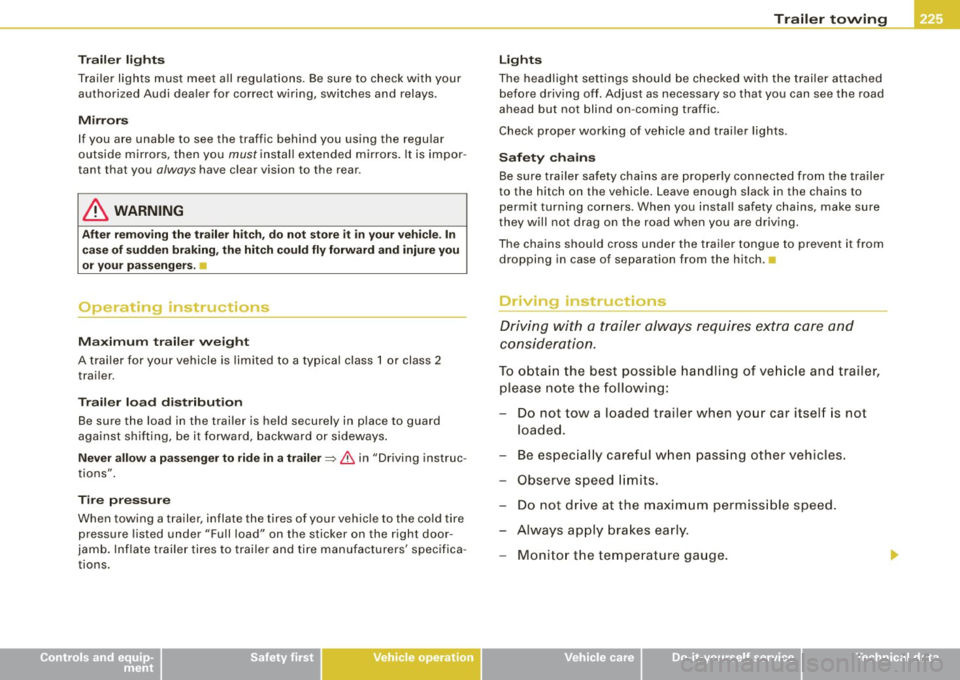
Trailer lights
Trailer lights must meet all regulations. Be sure to check with your autho rized Audi dealer for correct wiring , switches and relays .
Mirrors
If you are unable to see the traffic behind you using the regular
outside mirrors, then you
must install extended mirrors. It is impor
tant that you always have clear vision to the rear .
& WARNING
After removing the trailer hitch, do not store it in your vehicle. In
case of sudden braking, the hitch could fly forward and injure you
or your passengers .
.1
Operating instructions
Maximum trailer weight
A trailer for your vehicle is limited to a typical class 1 or class 2
trailer .
Trailer load distribution
Be sure the load in the trailer is held securely in place to guard
against shifting, be it forward, backward or sideways.
Never allow a passenger to ride in a trailer~&, in "Driving instruc
tions".
Tire pressure
When towing a trailer, inflate the tires of your vehicle to the cold tire
pressure listed under "Full load" on the sticker on the right door
jamb. Inflate trailer tires to trailer and tire manufacturers' specifica
tions.
Controls and equip ment Safety first Vehicle operation
Trailer towing
Lights
The
headlight settings should be checked with the trailer attached
before driving off. Adjust as necessary so that you can see the road
ahead but not blind on -coming traffic.
Check proper working of vehicle and trailer lights .
Safety chains
Be sure trailer safety chains are properly connected from the trailer
to the hitch on the vehicle. Leave enough slack in the chains to
permit turning corners. When you install safety chains, make sure
they will not drag on the road when you are driving.
The chains should cross under the trailer tongue to prevent it from
dropping in case of separation from the hitch .•
Driving instructions
Driving with a trailer always requires extra care and
consideration.
To obtain the best possible handling of vehicle and trailer,
please note the following:
Do not tow a loaded trailer when your car itself is not
loaded.
- Be especially careful when passing other vehicles.
Observe speed limits.
Do not drive at the maximum permissible speed.
- Always apply brakes early.
Monitor the temperature gauge.
Vehicle care Do-it-yourself service Technical data
Page 228 of 340
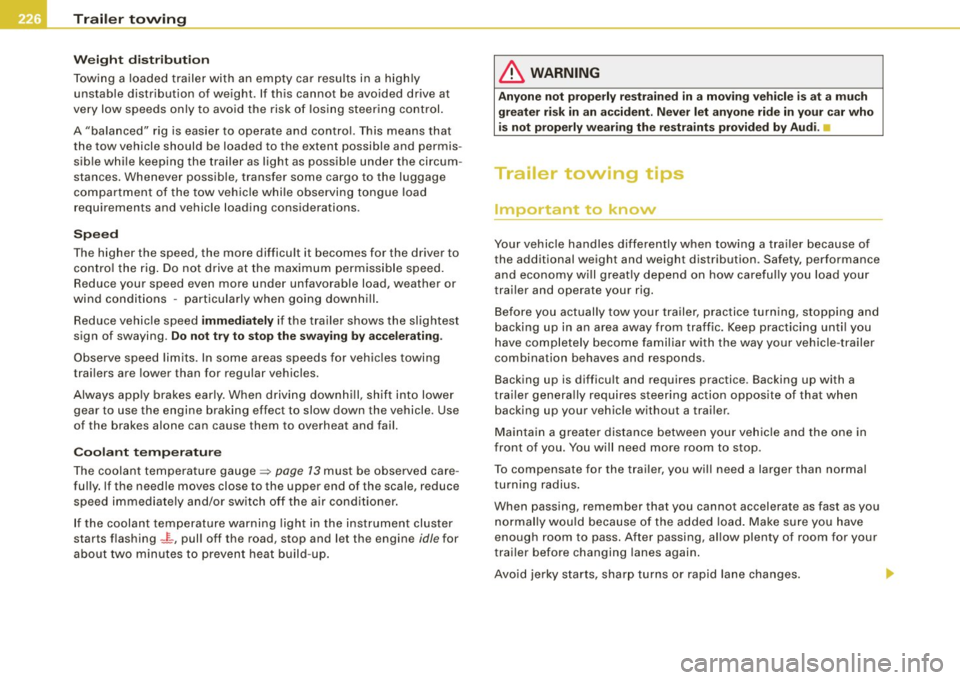
-Tr
aile r t owing ---=--------------
W eig ht dis tri buti on
Towing a loaded trailer with an empty car resu lts in a high ly
unstable distribution of weight . If this cannot be avoided drive at
ve ry low speeds only to avoid the risk of los ing steering control.
A "ba lanced" rig is easier to operate and control. This means that
the tow vehicle should be loaded to the extent possible and permis
sib le whi le keeping the trailer as light as possib le under the circum
stances. Whenever possible, transfer some cargo to the luggage
compartment of the tow vehicle while observing tongue load
requirements and vehicle loading considerations .
Speed
The higher the speed, the more difficult it becomes for the driver to
contro l the rig . Do not drive at the maximum permissible speed.
Reduce your speed even more under unfavorable load, weather or
wind condi tions -particularly when going downhill.
Reduce vehicle speed
imm ed iately if the trailer shows the slightest
sign of swaying.
Do not try to stop the s waying by a ccelerating .
Observe speed limits. In some areas speeds for vehic les towing
trai lers are lower than for regular vehicles.
Always app ly brakes early. When driving downhill, shift into lower
gear to use the engine braking effect to slow down the vehicle. Use
of the brakes alone can cause them to overheat and fail.
C oo lan t tem pe ra ture
The coolant temperature gauge~ page 73 must be observed care
fully. If the needle moves close to the upper end of the scale, reduce
speed immediately and/or switch off the air conditioner.
If the coolant temperature warning light in the instrument cluster
starts flashing -~- , pul l off the road, stop and let the engine
idle for
about two minutes to prevent heat build -up .
& WARNING
An yone not prop erl y r estr ained in a mo ving ve hic le is at a much
gre ater ri sk in an accident. N ever let an yone rid e in your car who
is not p roperl y wearing the r estraint s pro vid ed by Audi.
c
Trailer towing tips
Important to know
Your vehicle handles differently when towing a trai ler because of
the additional weight and weight distribution . Safety, performance
and economy will great ly depend on how carefu lly you load your
trai ler and operate your rig.
Before you actually tow your trailer, practice turn ing, stopping and
backing up in an area away from traffic. Keep practicing unti l you
have comp letely become familiar with the way your vehicle -trailer
combination behaves and responds .
Backing up is difficu lt and requires practice. Backing up with a
trailer genera lly requires s teering action opposite of that when
backing up your vehic le without a trailer.
Maintain a greater distance between you r vehicle and the one in
front of you. You will need more room to stop.
To compensate for the trailer, you wi ll need a larger than normal
turning radius .
When passing, remember that you cannot accelerate as fast as you nor mally wou ld because of the added load . Make sure yo u have
enough room to pass. After passing, allow plenty of room for your
trai ler before changing lanes again .
Avo id jerky starts, sharp turns o r rapid lane changes.
Page 229 of 340
![AUDI S4 CABRIOLET 2009 Owners Manual [ i ] Tip s
• Do not tow a trailer during the break-in period of your vehicle.
• If you tow a trailer, your Audi may require more frequent mainte
nance due to the ex AUDI S4 CABRIOLET 2009 Owners Manual [ i ] Tip s
• Do not tow a trailer during the break-in period of your vehicle.
• If you tow a trailer, your Audi may require more frequent mainte
nance due to the ex](/img/6/57654/w960_57654-228.png)
[ i ] Tip s
• Do not tow a trailer during the break-in period of your vehicle.
• If you tow a trailer, your Audi may require more frequent mainte
nance due to the ex tra load=>
page 316 . •
Parking on a slope
---'--------------------
Do not park with a trailer on a slope. If it cannot be
avoided, do so only after doing the following:
Wh en p arking :
-Apply the foot brake.
- Have someone p lace chocks under both the veh ic le and
the trailer wheels .
- Wit h chocks in p lace, s low ly release t he brakes until
wheel blocks absorb t he load.
- T urn t he wheels towards the curb .
- Apply the parking brake .
- Place an automatic transmission in
P , respect ively a
manual transmission in first or reverse gear.
Wh en restarting after p arking :
- Start the e ngine .
- Shift transmiss ion into gear.
- Re lease the parking brake and slowly pull out and away
from the w heel blocks.
- Stop and have someone retr ieve t he wheel blocks.
Controls and equip
ment Safety first Vehicle operation
Tr
aile r to wing
[ i ] Tip s
If you move the selector lever of the automatic transmission to P
before applying the parking brake and before blocking the wheels,
you may have to use more force later to move the lever out of the
P
position .•
Vehicle care Do-it-yourself service Technical data
Page 230 of 340
